Zesty Dairy-Free Lemon Bars: A Bright & Buttery Allergy-Friendly Treat
Dairy-Free Lemon Bars are a true taste of sunshine, delivering all the classic lemon bar goodness without any butter or dairy. These irresistible treats are intensely lemony, wonderfully bright, perfectly sweet, and feature a rich, tender, shortbread-style crust that will surprise you with its buttery texture despite being completely dairy-free. They are incredibly versatile, making them a delightful addition to baby or wedding showers, vibrant spring picnics, casual potlucks, or thoughtful housewarming gifts. For those with specific dietary needs, rest assured, as gluten-free adaptations are thoughtfully included further down in this comprehensive guide!

Why These Dairy-Free Lemon Bars Will Become Your New Favorite
Prepare to fall in love with these vibrant lemon bars. They are more than just a dessert; they’re an experience, and here’s why they’ll quickly become a staple in your recipe collection:
- Authentic, Traditional Flavor. Don’t let the “dairy-free” label fool you! These lemon bars capture the beloved traditional taste you know and adore. Crafted without butter, milk, or any other dairy-based ingredients, they still achieve that perfect balance of sweet and tangy, with an intense citrusy burst that’s characteristic of classic lemon bars. The secret lies in a rich, tender, and perfectly crumbly shortbread crust that provides the ideal foundation for the luscious lemon filling, ensuring an experience indistinguishable from their dairy-laden counterparts.
- Remarkably Allergy-Friendly. This innovative recipe makes the joy of lemon bars accessible to everyone. Designed specifically to be dairy-free, it’s a game-changer for individuals with lactose intolerance, dairy allergies, or those following a vegan diet. Now, you can confidently share these delightful treats with friends and family, knowing that everyone can enjoy a slice of this sunshine-filled dessert without worry.
- Perfect for Any Gathering. While there’s truly never a wrong time for a delicious lemon bar, these dairy-free versions are especially fantastic for social occasions. Their bright flavor and elegant appearance make them a superb addition to almost any event – from a sophisticated baby or wedding shower to a laid-back spring picnic, a bustling potluck, or a festive birthday celebration. They’re easy to transport and always a crowd-pleaser, guaranteeing smiles all around.
- An Excellent Way to Utilize Fresh Lemons. If your kitchen is overflowing with an abundance of fresh lemons, this dairy-free lemon dessert offers a wonderful and flavorful solution for using them up. The recipe calls for the juice and zest from approximately 4-5 large lemons, making it an ideal choice for transforming that citrus bounty into something truly spectacular. The vibrant flavor of fresh lemons is paramount to the success of this recipe, so embrace the zest and juice for an unparalleled taste.
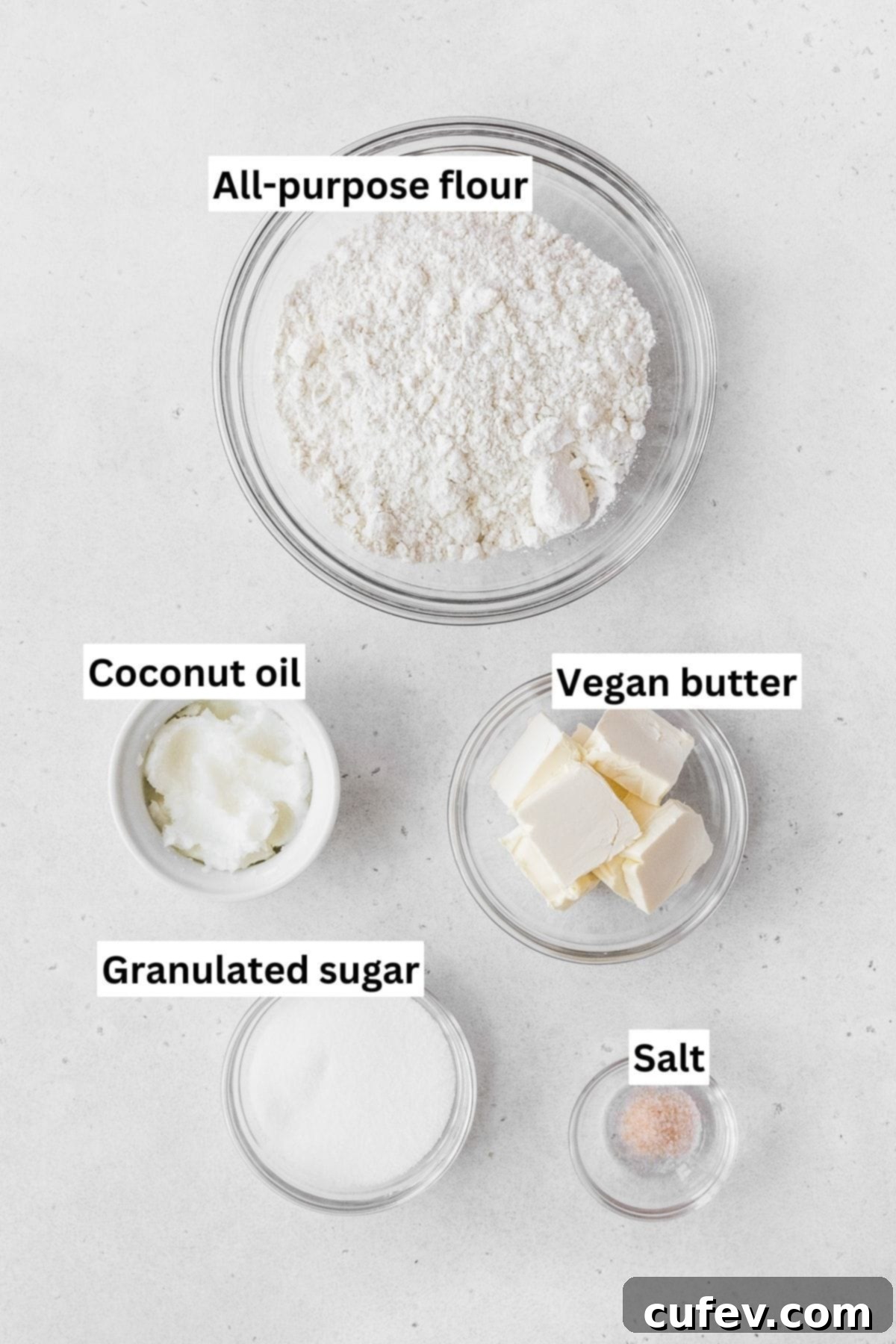

Essential Ingredients for Your Dairy-Free Lemon Bars
Creating this delightful dairy-free lemon dessert requires just a handful of readily available ingredients. Each component plays a crucial role in achieving the perfect texture and flavor profile:
- Fresh Lemon Juice: The heart and soul of this dessert! Freshly squeezed lemon juice will undoubtedly deliver the most vibrant and authentic flavor, offering that unparalleled zesty punch. While bottled lemon juice can be used in a pinch, we highly recommend fresh for the best results. You’ll need the juice from about 4-5 large lemons.
- Lemon Zest: Don’t underestimate the power of zest! It’s packed with essential oils that intensify the lemon flavor without adding extra acidity. You’ll need the finely grated zest from approximately 2 large lemons to truly make these bars shine.
- All-Purpose Flour: This forms the foundational structure of our tender, shortbread-like crust. For a seamless experience, ensure your flour is fresh and properly measured.
- Granulated Sugar: This essential sweetener balances the tartness of the lemon, contributing to both the delightful sweetness of the crust and the luscious filling.
- Vegan Butter: The star of our dairy-free substitute list! High-quality vegan butter is key to achieving that rich, authentic buttery flavor and tender texture in both the crust and the filling, mimicking traditional butter perfectly without any dairy. Look for stick varieties that are firm when cold for best results.
- Cornstarch: A vital thickening agent for the lemon filling. Cornstarch ensures your dairy-free lemon curd becomes beautifully smooth, thick, and luscious, preventing a runny consistency.
- Large Eggs: Eggs provide structure, richness, and emulsification in the lemon curd. You will need a total of 6 large eggs for this recipe; specifically, three whole eggs and the yolks from three additional eggs. The extra yolks contribute to an incredibly rich and creamy texture.
- Salt: A pinch of salt is a culinary secret weapon! It cleverly enhances and balances the sweetness in this lemon dessert, while also accentuating the bright, tangy citrus flavors, preventing the bars from tasting flat.
- Powdered Sugar (Optional): For an elegant finish, a light dusting of powdered sugar over the tops of the cooled non-dairy lemon bars adds a touch of sweetness and a beautiful visual appeal before serving.
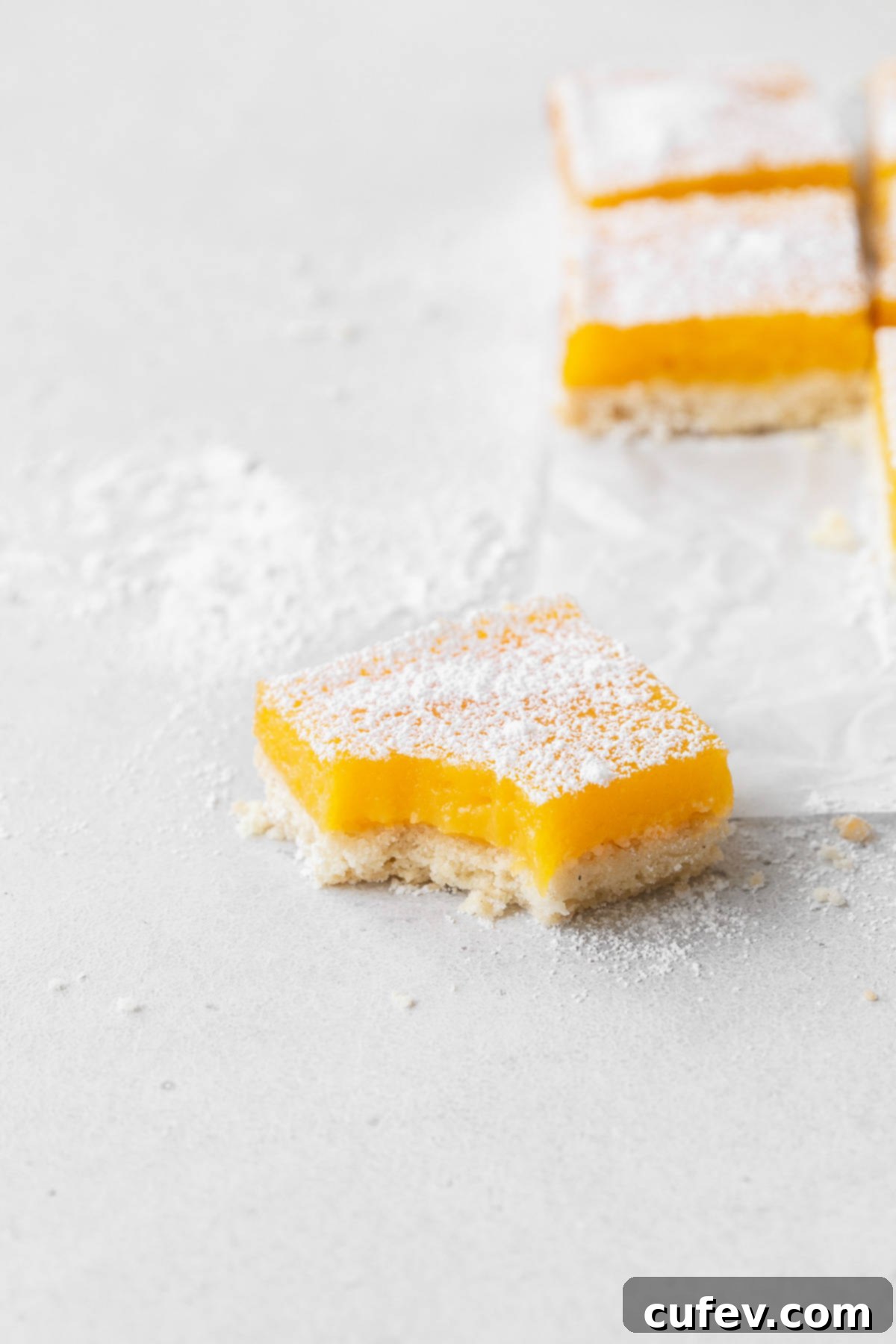
Crafting Your Own Dairy-Free Lemon Bars: A Step-by-Step Guide
While these exquisite lemon bars involve a few distinct stages, each step is straightforward and the culminating result—a burst of sunshine in every bite—is undeniably worth the effort. Follow these instructions carefully for perfect dairy-free lemon bars.
Part 1: Preparing the Dairy-Free Shortbread Crust
The foundation of any great lemon bar is a perfectly tender, buttery crust. Here’s how to achieve it:
- Step 1: Begin by preheating your oven to 350°F (175°C). Next, line an 8×8-inch square baking pan with parchment paper, ensuring that the paper extends up all sides of the pan. This creates “handles” for easy removal of the baked bars later.
- Step 2: In a medium-sized mixing bowl, combine the all-purpose flour, granulated sugar, and fine salt. Whisk these dry ingredients thoroughly to ensure they are evenly distributed, creating the base for your rich shortbread crust.
- Step 3: Add the cold, cubed vegan butter to the flour mixture. Now, you’ll need to work the butter into the flour until the mixture resembles coarse meal with some pea-sized crumbs. You can achieve this using a fork, a pastry cutter, or your fingertips. For a quicker method, a food processor can also be used; pulse until the desired consistency is reached.
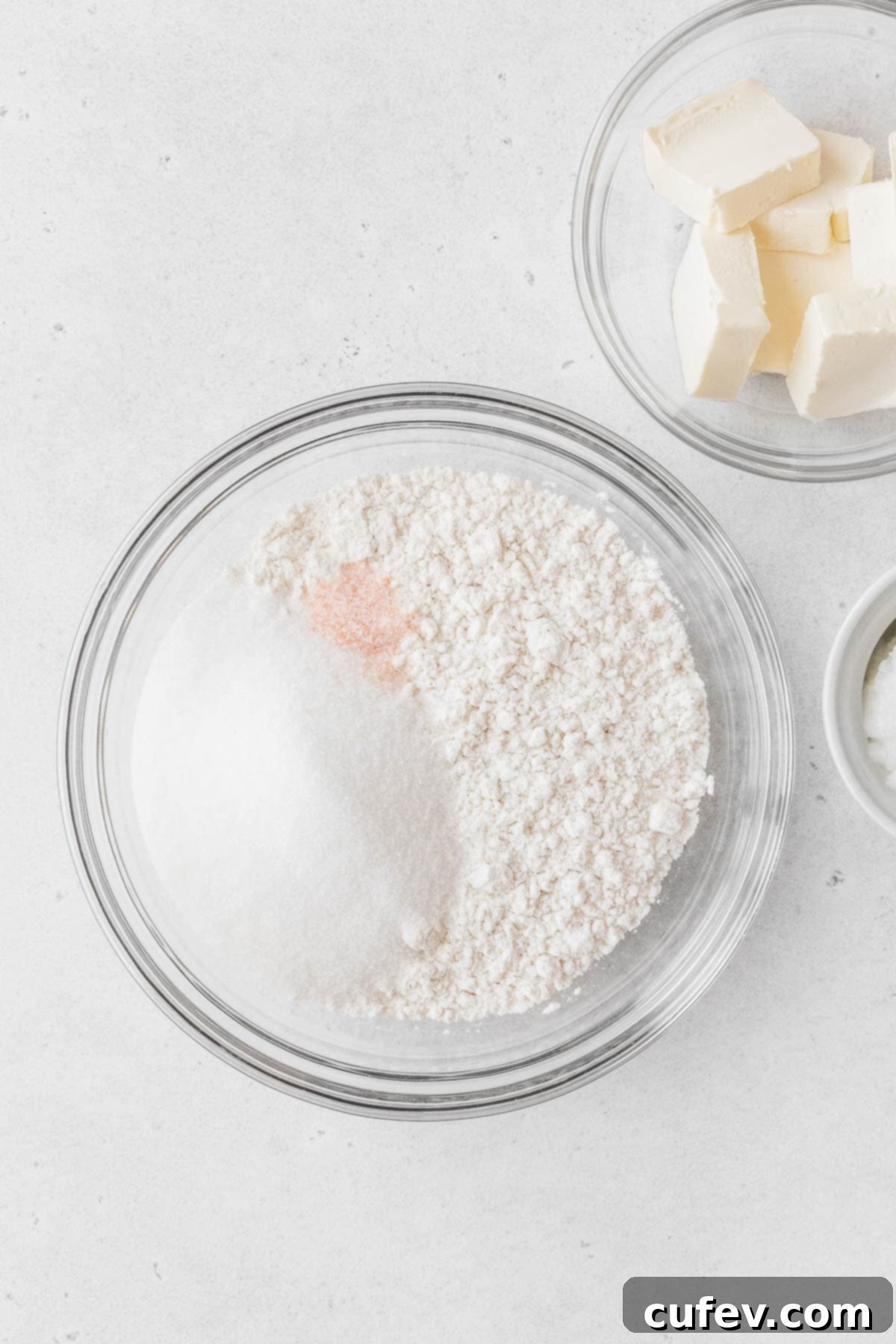
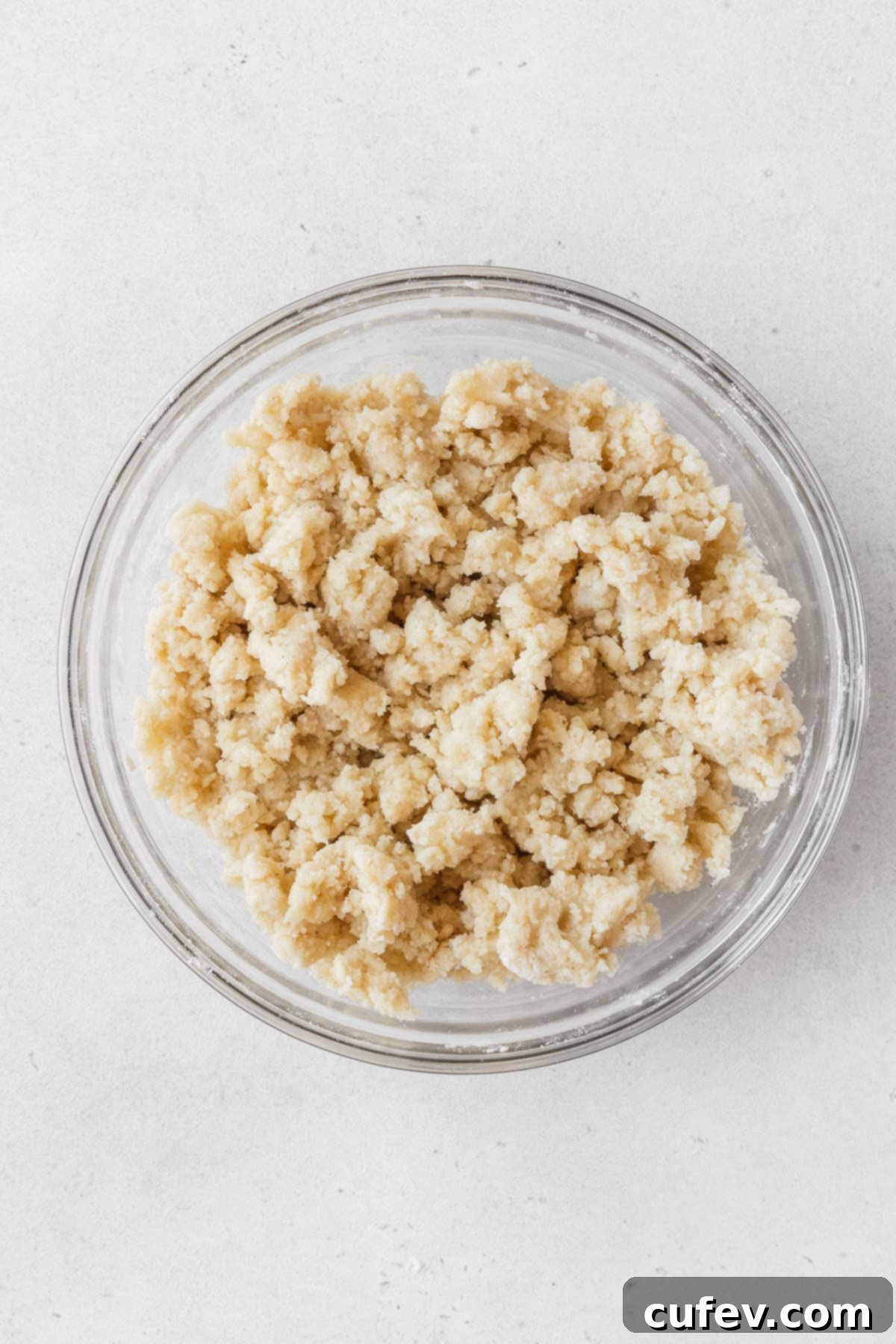
- Step 4: Transfer the dough mixture into your prepared 8×8-inch pan. Using the back of a spoon or your fingertips, press the dough firmly and evenly into a flat, compact layer across the bottom of the pan. If the dough feels too soft to work with, place the pan in the freezer for about 5 minutes to firm it up, making it easier to press.
- Step 5: Once pressed, place the pan in the freezer for an additional 5 minutes to thoroughly chill the dough. This step is crucial for preventing the crust from shrinking during baking. Then, bake the chilled crust in the preheated oven for 30 minutes, or until the edges turn a beautiful golden brown.
- Step 6: Carefully remove the baked crust from the oven and set it aside to cool completely. This cooling period is important before adding the lemon filling.
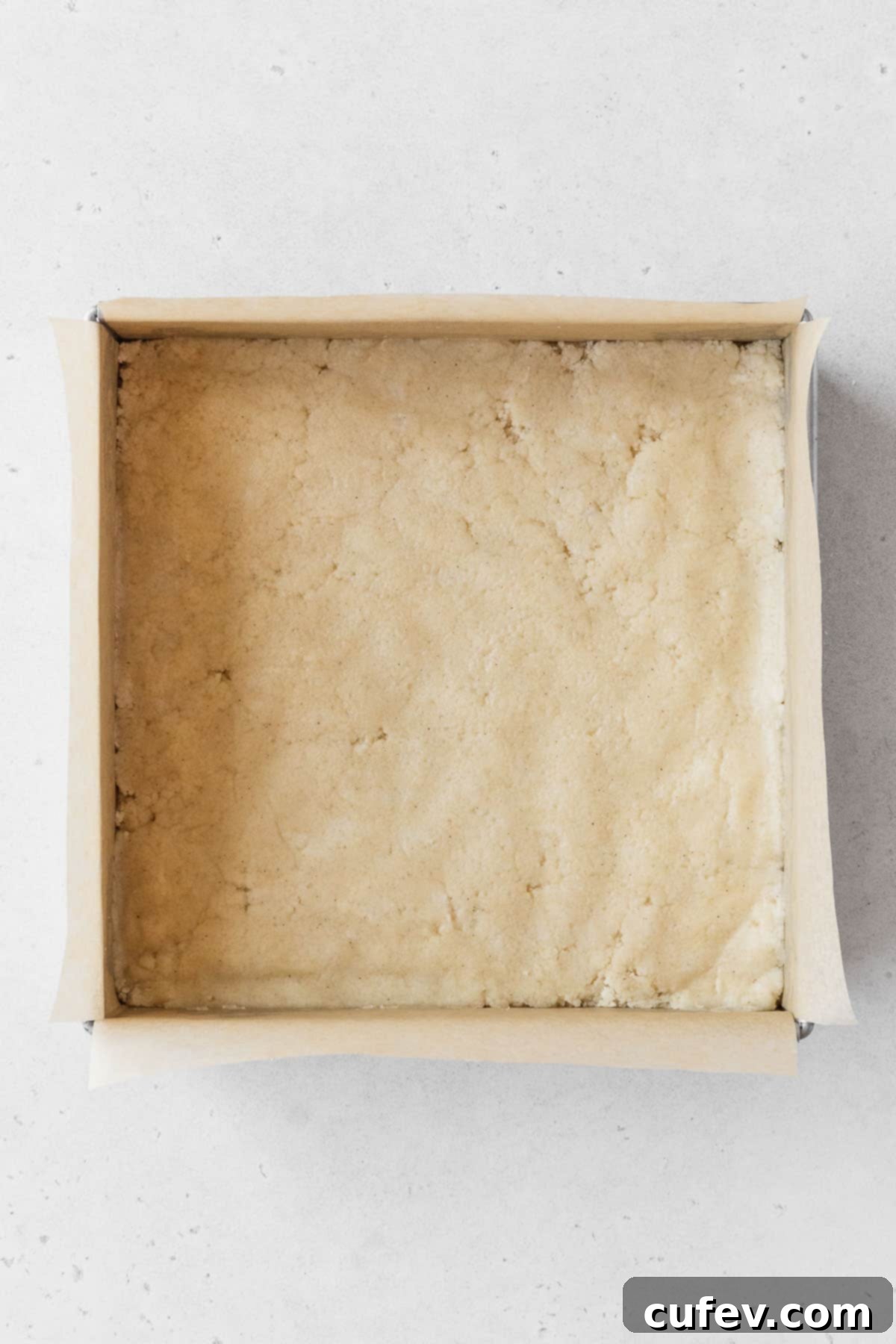

Part 2: Preparing the Luscious Dairy-Free Lemon Curd Filling
This creamy, tangy filling is the star of the show. Achieving its smooth consistency requires careful attention:
- Step 1: While your crust is cooling down, adjust the oven temperature and preheat it to 325°F (160°C) for the next baking stage.
- Step 2: In a bowl, combine the granulated sugar with the fresh lemon zest. Use your fingers to vigorously rub and pinch the lemon zest into the sugar. This crucial step releases the aromatic oils from the zest, infusing the sugar with intense lemon flavor.
- Step 3: Transfer the lemon-infused sugar and cornstarch into a medium saucepan. Whisk them together thoroughly until uniformly combined. This prevents lumps and ensures the cornstarch is evenly dispersed before liquids are added.
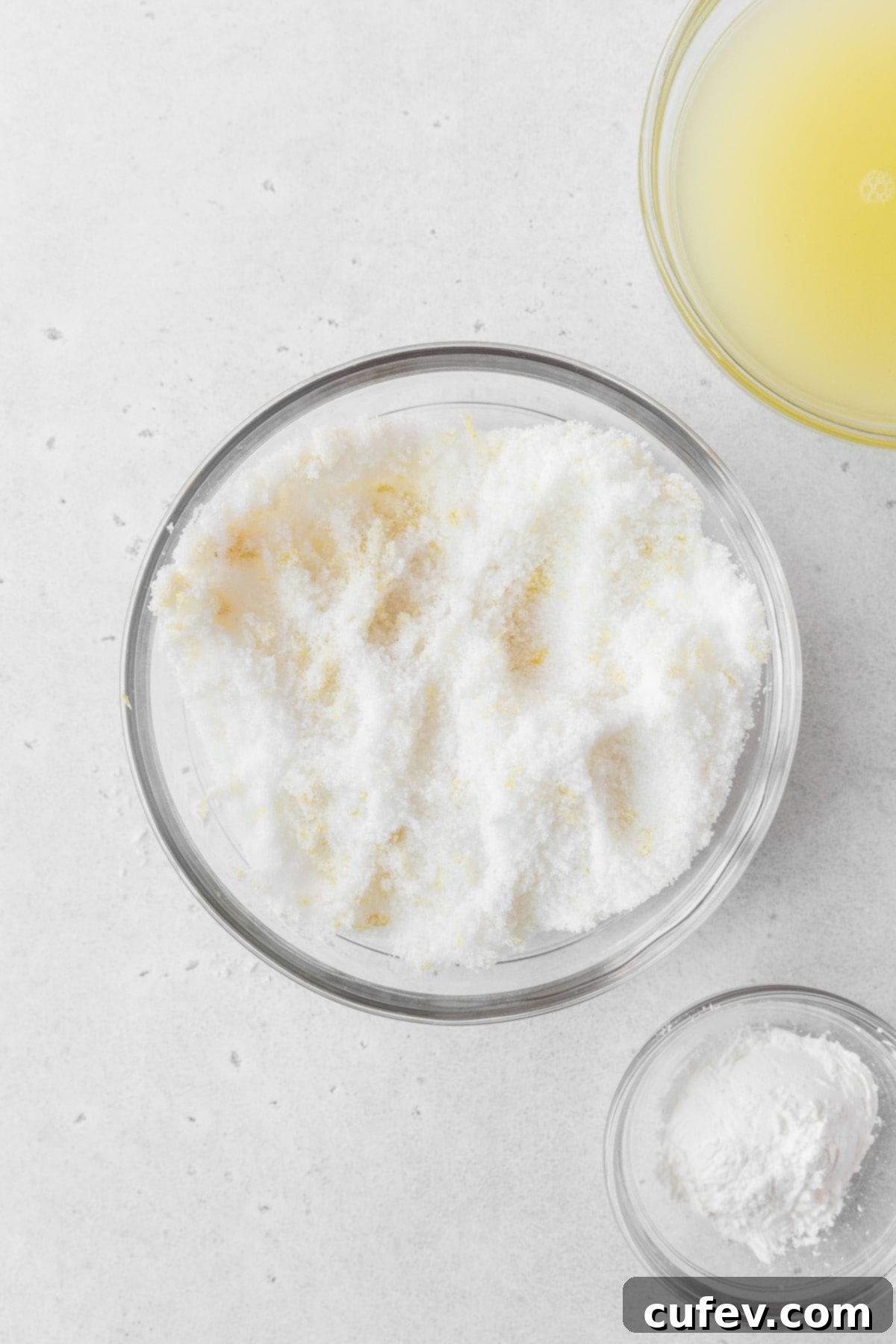
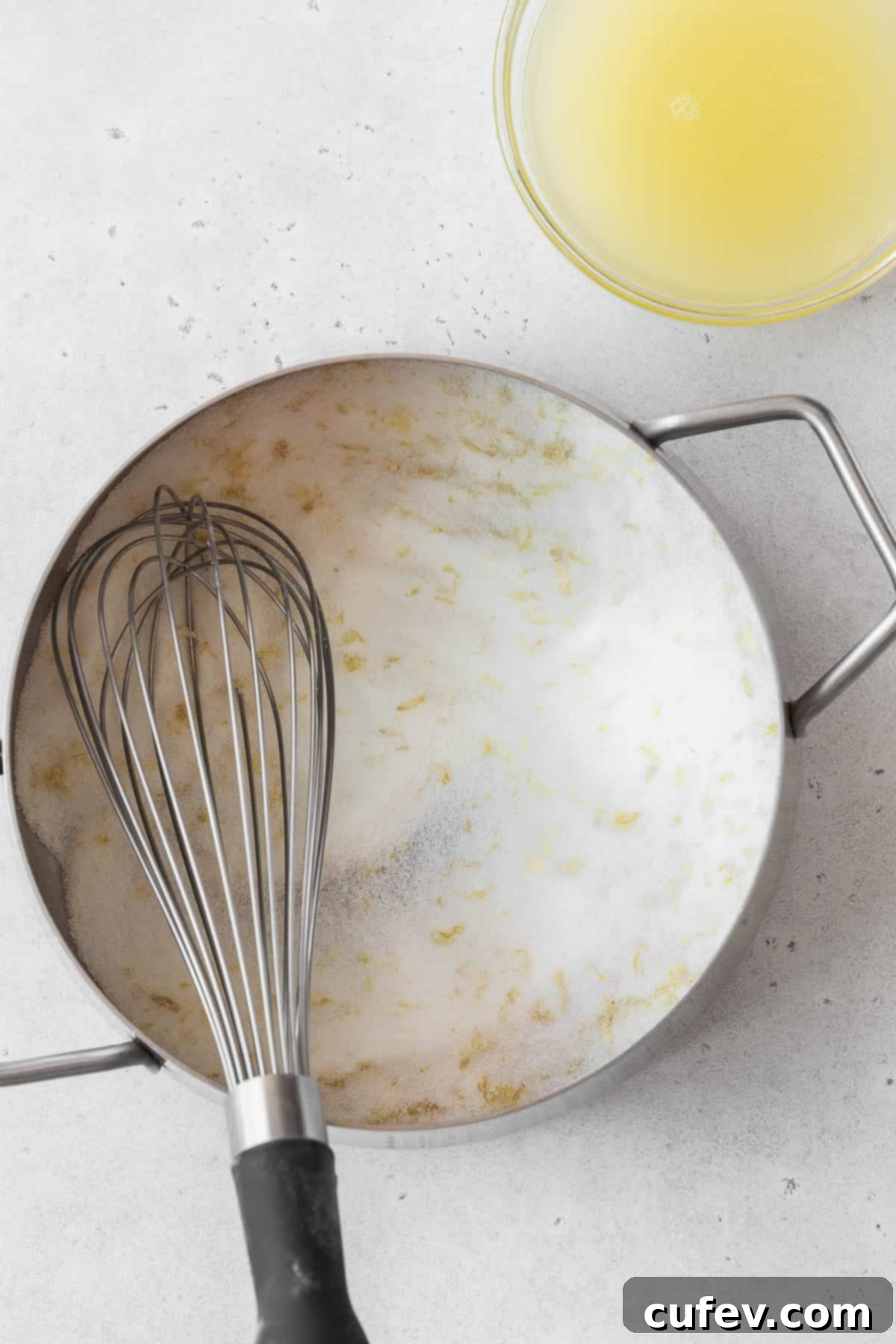
- Step 4: Pour the fresh lemon juice and a pinch of salt into the saucepan with the sugar-cornstarch mixture. Place the pan over medium heat and whisk continuously or at least very frequently for 2-3 minutes. Observe closely: the mixture will begin to thicken slightly, taking on a more syrupy consistency. Once this happens, immediately remove the pan from the heat to prevent overcooking.
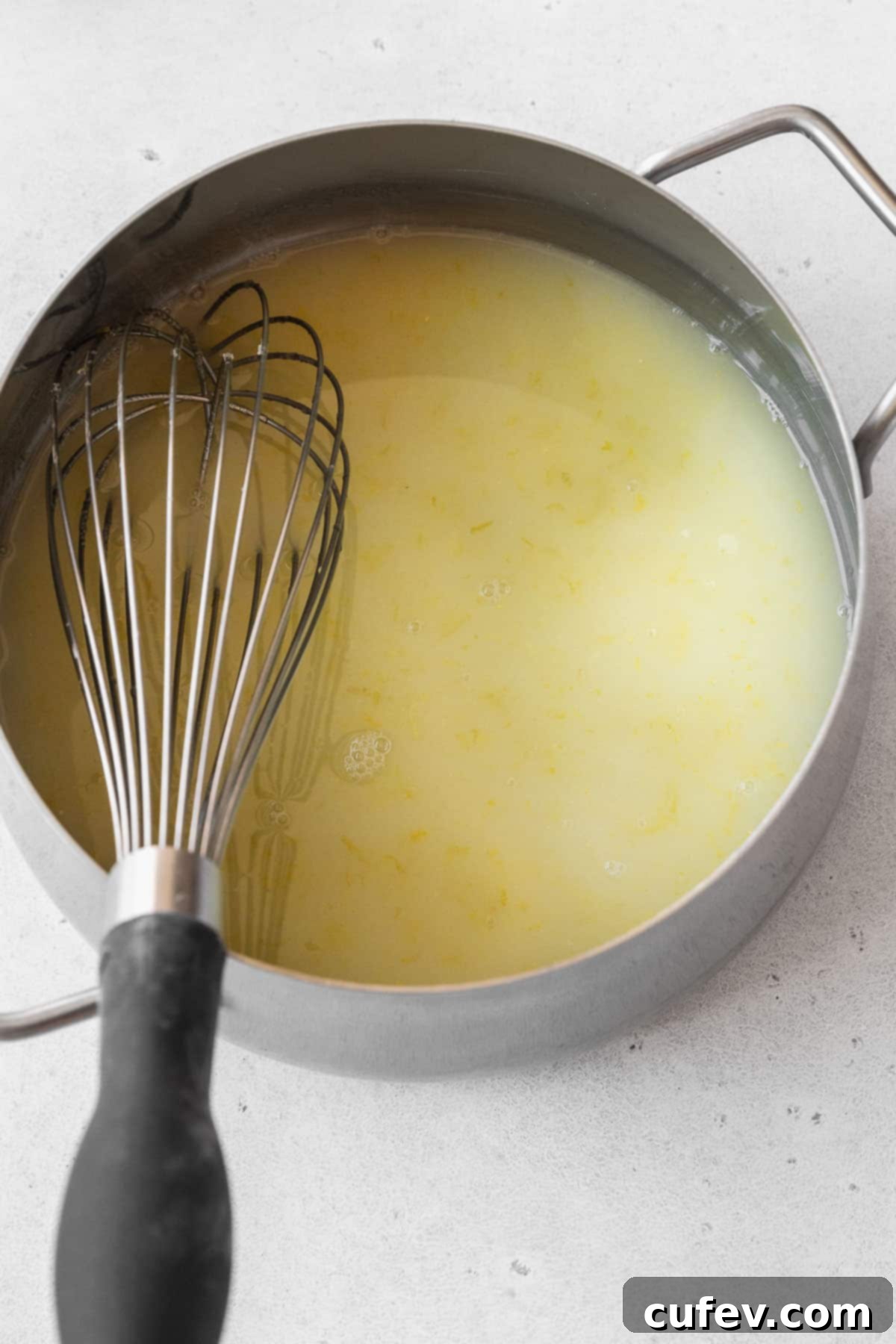
- Step 5: In a separate large bowl, crack the three whole eggs and add the three egg yolks. Whisk them together thoroughly until they are completely smooth and uniform in color, ensuring no streaks remain. This prepares them for tempering.
- Step 6: This is a critical step for preventing scrambled eggs: While whisking the eggs in the bowl constantly and vigorously, slowly drizzle in the hot lemon juice mixture, adding it in small increments of about ¼ cup at a time. The continuous whisking and slow addition allow the eggs to gradually warm up without cooking too quickly, effectively “tempering” them.
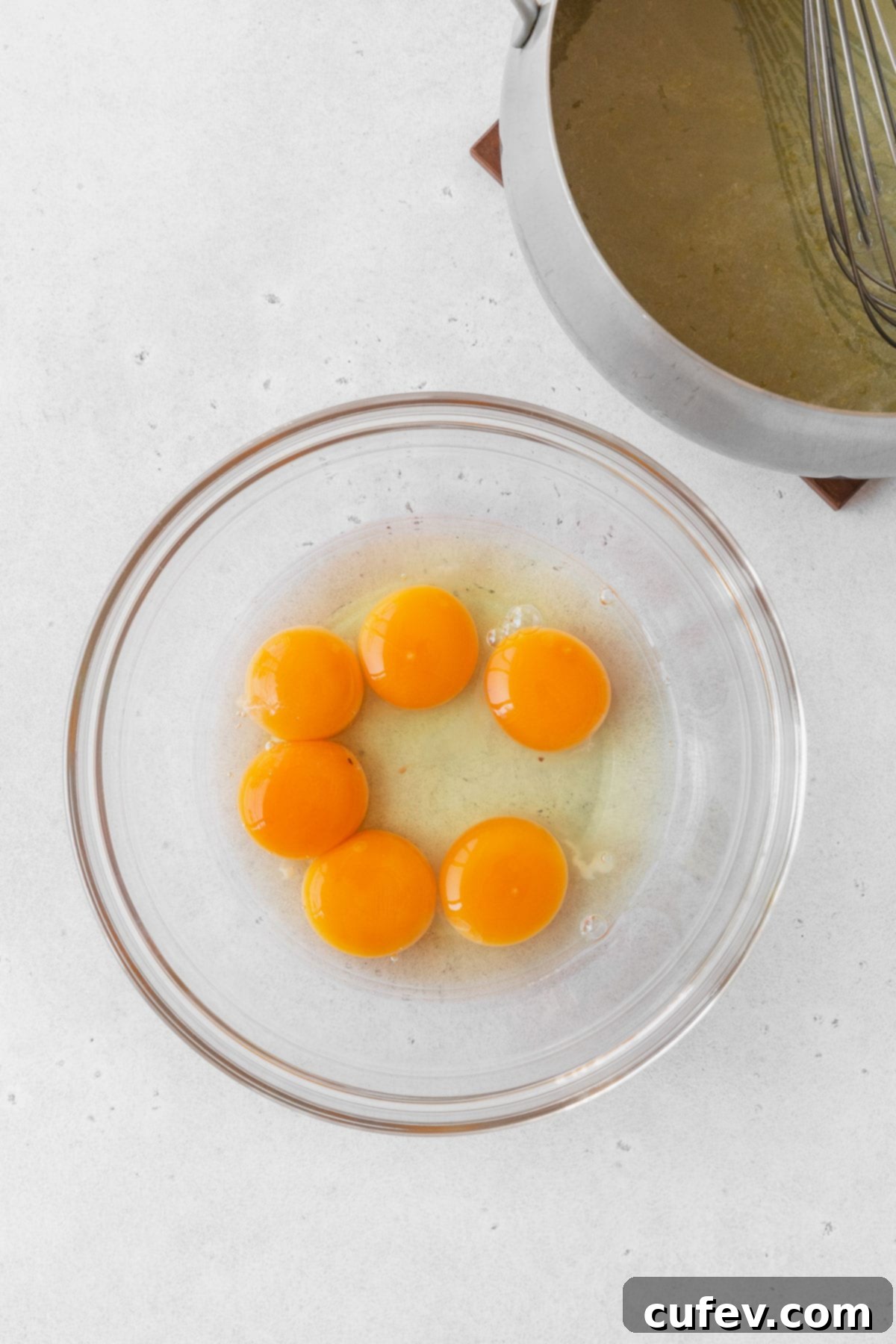
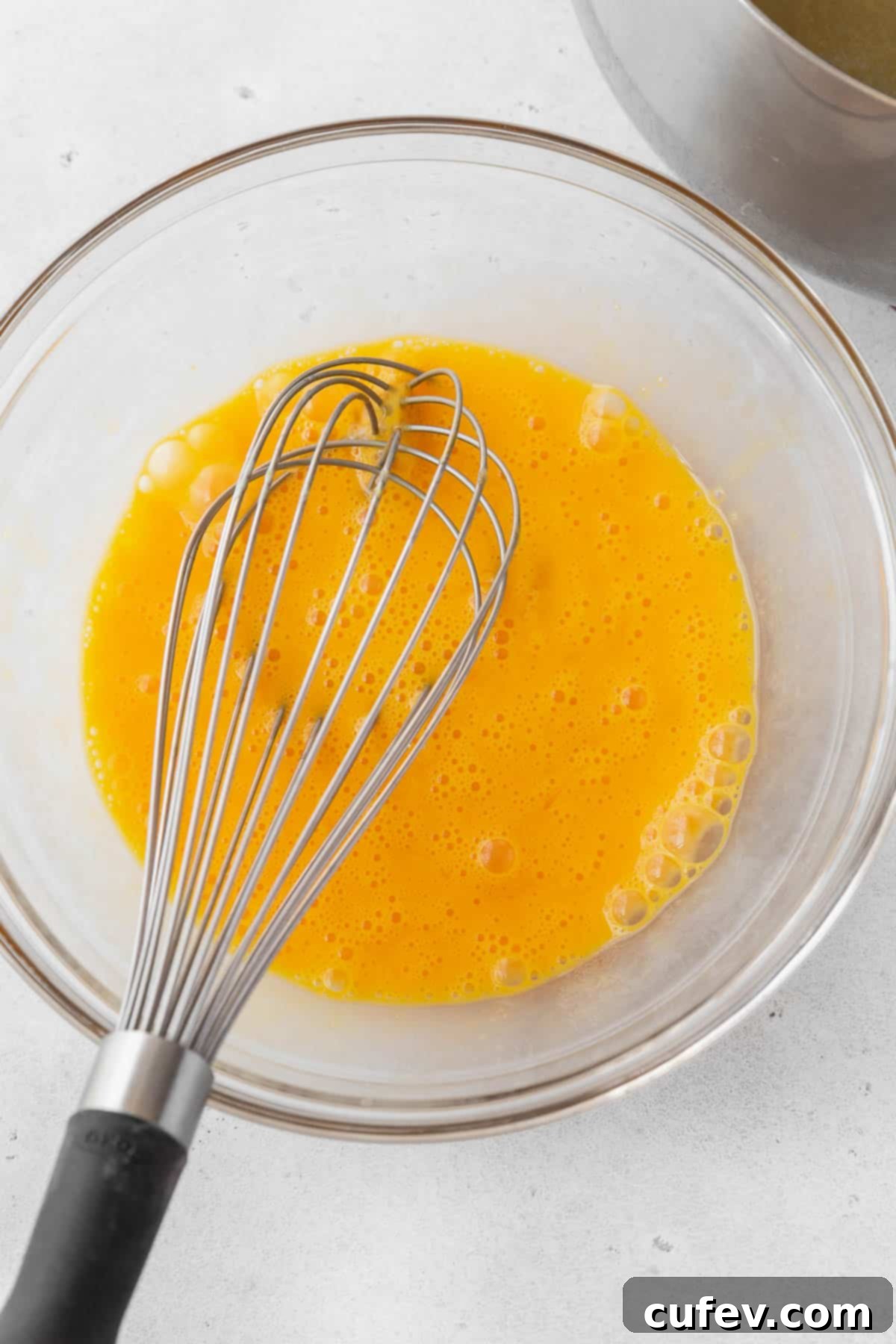
- Step 7: Once all of the hot lemon juice mixture has been successfully incorporated into the eggs, pour the entire combined mixture back into the saucepan. Return the saucepan to the stovetop and heat it over medium-low heat, continuing to whisk constantly. This ensures even cooking and prevents the eggs from sticking or scrambling.

- Step 8: Continue cooking and whisking for approximately 5-7 minutes. The lemon curd is ready when it reaches a temperature of 175°F (79°C) on an instant-read thermometer, or when it becomes thick enough to generously coat the back of a spoon, leaving a clear path when you draw your finger across it. Immediately remove the saucepan from the heat once this consistency is achieved.
- Step 9: Place a fine-mesh sieve over a clean bowl. Carefully pass the hot lemon curd through the sieve. This essential step removes any bits of lemon zest and ensures a perfectly smooth, silky texture by catching any tiny hardened pieces of egg that might have formed despite careful tempering.
- Step 10: While the curd is still warm, add the remaining vegan butter, one tablespoon at a time, mixing thoroughly after each addition until it is fully melted and incorporated. This process makes the lemon curd incredibly smooth, glossy, and luxurious.
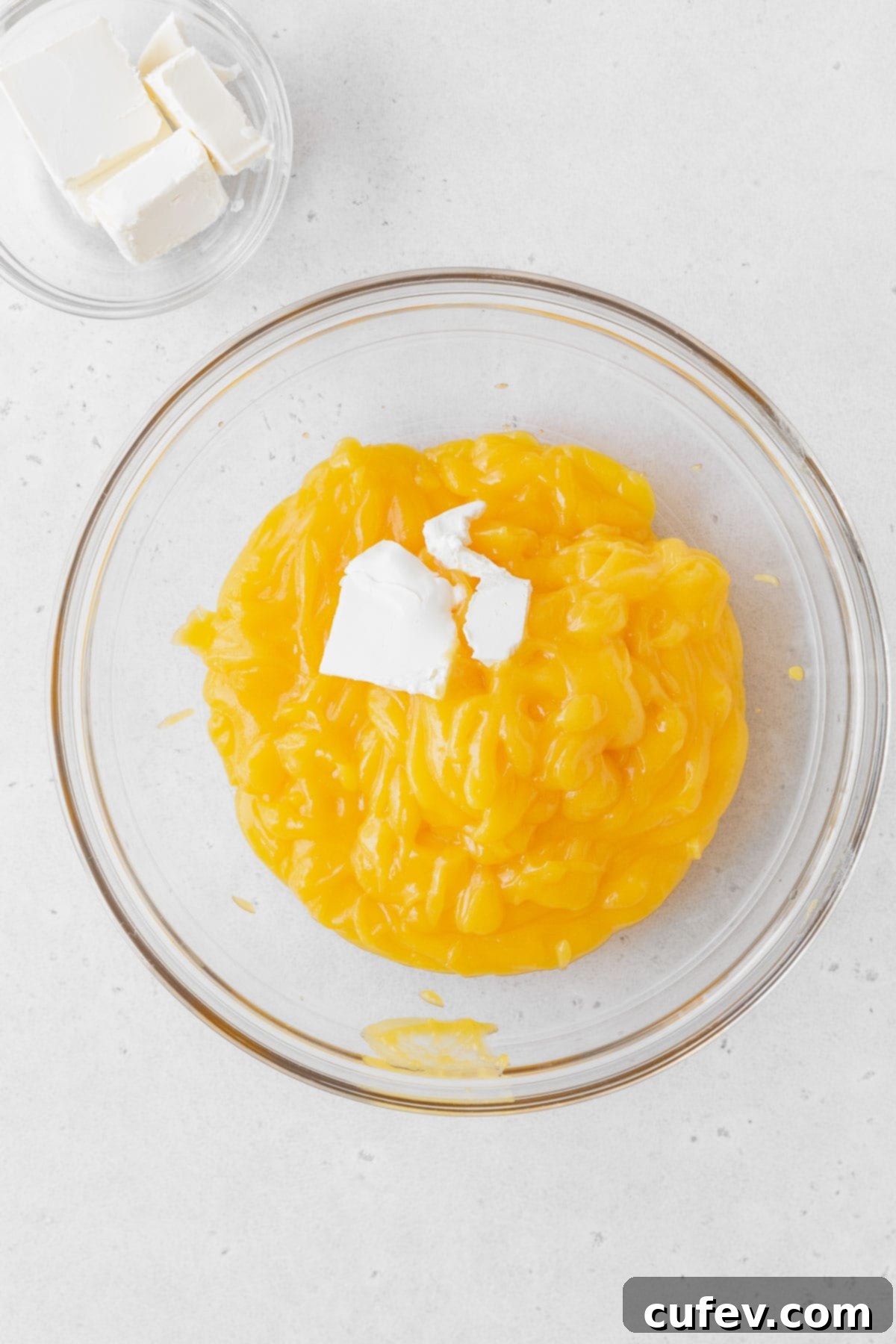

- Step 11: Pour the warm, silky lemon curd evenly over the cooled shortbread crust. Use an offset spatula or the back of a spoon to gently spread and smooth the surface, ensuring a uniform layer.
- Step 12: Carefully transfer the pan back into the preheated oven. Bake the lemon bars for an additional 20-25 minutes. The bars are done when the filling appears mostly set but still has a slight, gentle jiggle in the center when you delicately shake the pan. Avoid overbaking, as this can lead to a less creamy texture.
- Step 13: Once baked, remove the pan from the oven and allow the lemon bars to cool completely at room temperature within the pan for about 2 hours. After reaching room temperature, transfer the pan to the refrigerator and chill for at least 1-2 hours. This chilling time is crucial for the bars to firm up and set properly, making them easy to cut.
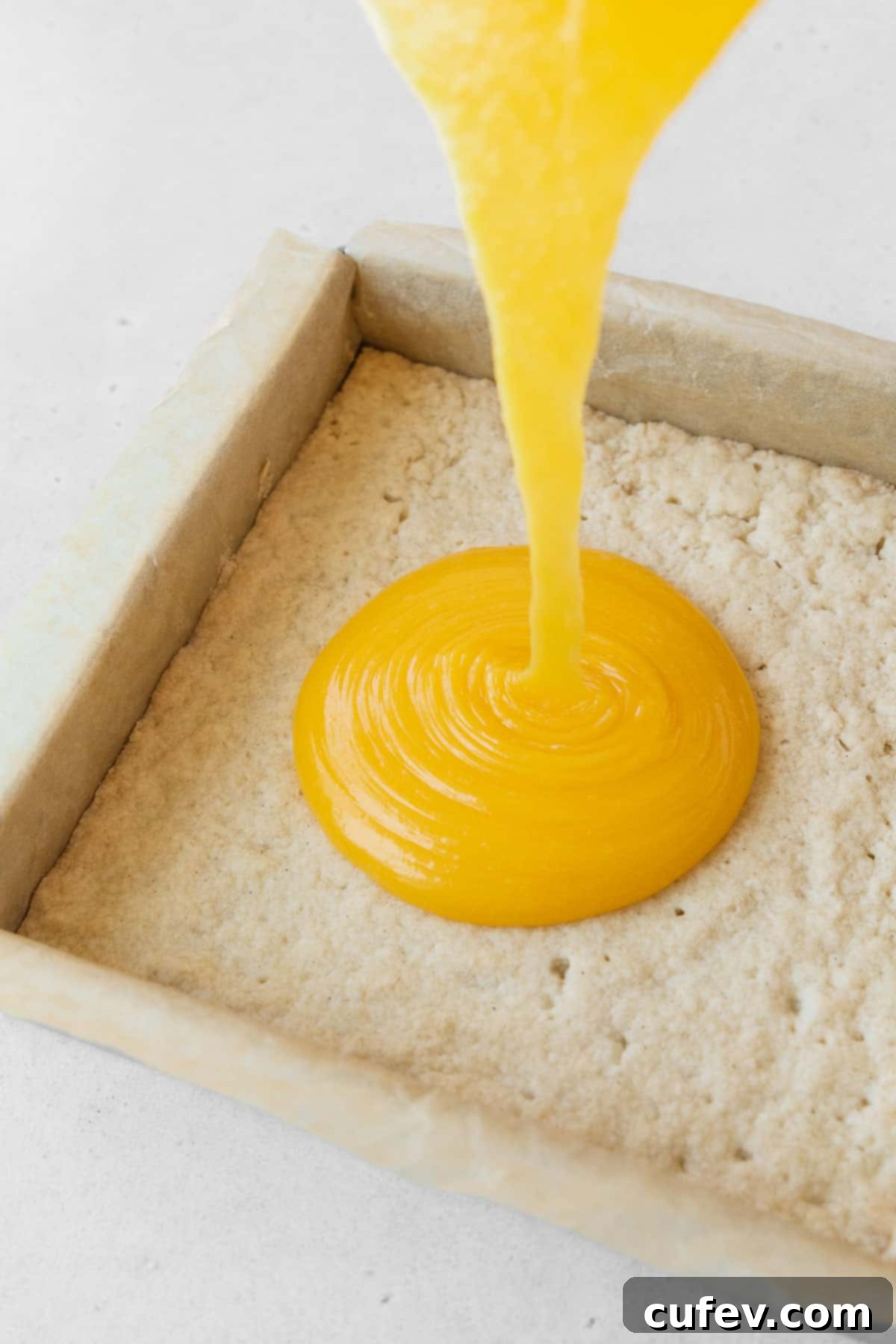

- Step 14: Once thoroughly chilled, carefully lift the entire slab of lemon bars out of the pan using the parchment paper handles. Place it on a cutting board. Using a sharp knife, trim the edges (optional, for neatness) and then cut the lemon bars into desired squares or rectangles. For the cleanest cuts, wipe the knife blade clean with a damp cloth after each slice. If desired, dust liberally with powdered sugar just before serving. Enjoy these bright, zesty treats!

Pro Tips for Perfect Dairy-Free Lemon Bars Every Time
Achieving bakery-quality dairy-free lemon bars is easier than you think with these expert tips:
- Always Use Cold Vegan Butter for the Crust. The secret to a truly tender and “buttery” shortbread crust lies in using cold vegan butter. Just like with traditional pie crusts, cold fat creates pockets of steam during baking, resulting in a delightfully flaky and rich texture. Make sure your vegan butter is straight from the refrigerator and cut into small pieces before you start.
- Mastering the Butter Integration for the Crust. When incorporating the cold vegan butter into the flour mixture, aim for a texture that resembles coarse meal, with some larger pea-sized crumbs remaining. This ensures that the butter doesn’t fully melt into the flour, which is key for a tender, flaky crust. You can achieve this using a pastry cutter, a fork, or even your fingertips (working quickly to avoid warming the butter too much). A food processor can also do this efficiently with quick pulses.
- Chill the Dough if It’s Too Soft. If, while pressing the shortbread dough into your baking pan, you find it becoming too soft or sticky, don’t hesitate to pop the pan into the freezer for 5-10 minutes. Working with a firm, cold dough is crucial for preventing the crust from shrinking during baking and ensuring a crisp, uniform base.
- Addressing “Sweating” Lemon Bars. It’s not uncommon for small beads of water (often referred to as “sweating”) to appear on the surface of lemon bars, especially if they are covered tightly while chilling in the refrigerator. This is due to condensation as the bars cool. If your bars sweat, simply blot the top gently with a paper towel before you dust them with powdered sugar. This won’t affect the taste or texture.
Essential Tips for a Silky Smooth Lemon Curd Filling
The dairy-free lemon curd filling is designed to be ultra-smooth and creamy, thanks to its custard base. The key to achieving this luxurious texture, without any undesirable scrambled egg bits, is to introduce heat to the egg mixture very gradually. Scrambling occurs when eggs are exposed to too much heat too quickly. Therefore, the tempering process is paramount: very slowly drizzle the hot lemon juice mixture into the whisked eggs, adding only about ¼ cup at a time, while continuously whisking the eggs vigorously. Ensure each small addition of the lemon juice mixture is fully incorporated into the eggs before adding the next portion. This gentle, gradual warming of the eggs is what creates that perfect, custardy consistency. Don’t rush this step—patience here yields delicious rewards!

Storage and Freezing Guidelines
Proper storage ensures your dairy-free lemon bars remain fresh and delicious for longer:
- Refrigeration: Leftover dairy-free lemon bars can be stored in an airtight container in the refrigerator for 3-4 days. While covering them might lead to some condensation on the surface (as mentioned in the tips), this will not impact the exquisite flavor or delightful texture of your lemon bars.
- Freezing: For longer preservation, these bars freeze beautifully! We recommend wrapping individual squares tightly in parchment paper, then placing them in a freezer-safe airtight container or heavy-duty freezer bag. They can be frozen for up to 3 months, making them a fantastic make-ahead dessert.
- Defrosting: To enjoy your frozen lemon bars, simply thaw them at room temperature for 30 minutes to 1 hour. Alternatively, you can move them to the refrigerator for 2-3 hours to gradually thaw before serving.
Dietary Adaptations for All Needs
This recipe is already wonderfully accommodating, being naturally dairy-free, butter-free, and vegetarian. To effortlessly transform these into delicious gluten-free and dairy-free lemon bars, simply substitute the all-purpose flour with a high-quality 1-to-1 gluten-free baking flour blend. Make sure to choose a blend specifically designed for cup-for-cup replacement in baking. When developing this recipe, I achieved perfect results using 1¼ cups (185g) of Bob’s Red Mill Gluten-Free 1-to-1 Baking Flour. Follow the rest of the recipe directions exactly as listed, and you’ll be enjoying fantastic lemon bars suitable for even more dietary preferences!
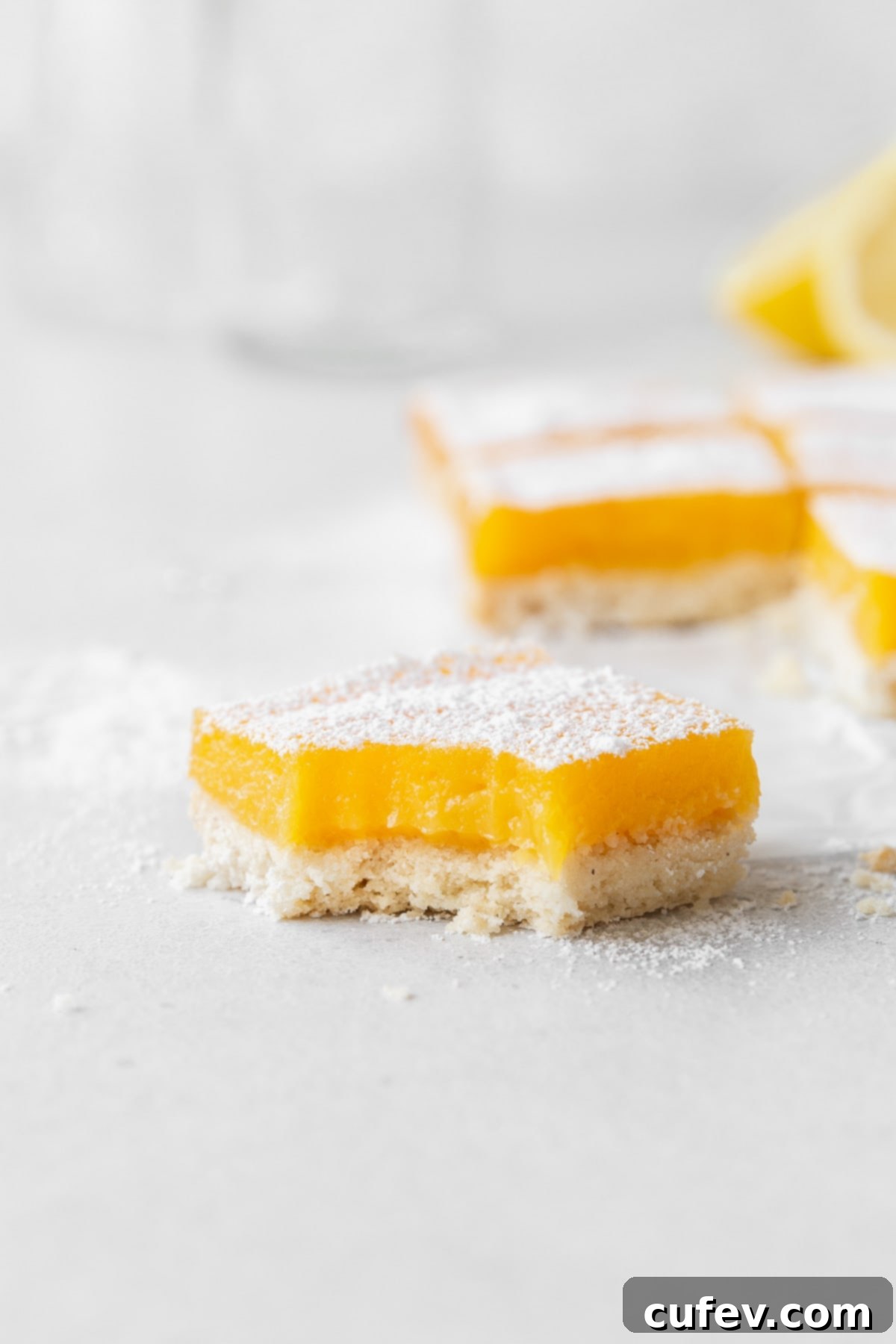
Frequently Asked Questions About Dairy-Free Lemon Bars
Traditional lemon bar crust is fundamentally a shortbread base. This delectable foundation is typically composed of simple ingredients: all-purpose flour, granulated sugar, a touch of salt, and cold butter. In our dairy-free version, we skillfully replace the dairy butter with a high-quality vegan butter to achieve the same rich, crumbly, and tender texture that perfectly complements the bright lemon filling.
If your lemon bars turn out runny, it’s most commonly because the lemon curd filling hasn’t fully cooked and set properly. This can happen for a couple of reasons: either the custard wasn’t adequately thickened on the stovetop before being poured onto the shortbread crust, or it simply didn’t bake long enough in the oven. To prevent this common issue, ensure that when you’re cooking the curd on the stovetop, it reaches a thick enough consistency to generously coat the back of a spoon (or ideally, 175°F / 79°C on an instant-read thermometer). Additionally, once the bars are in the oven, only remove them when the filling appears mostly firm but still has a slight, gentle jiggle in the center when the pan is carefully shaken. Patience in cooking and chilling is key to achieving that perfect, stable lemon curd.
If your lemon bars are struggling to set, it almost always indicates that they haven’t been cooked for a sufficient amount of time or chilled long enough. The lemon curd needs heat to thicken and create its custard-like structure. The best course of action is to return them to the oven and continue baking until the filling looks mostly firm but still has a very slight, delicate jiggle when the pan is gently nudged. After baking, remember that adequate cooling and chilling time in the refrigerator (at least 1-2 hours) is absolutely crucial for the bars to fully firm up and become sliceable. Don’t rush the cooling process!
Discover More Dairy-Free Baking Delights
If you loved these vibrant lemon bars, you’re in for a treat! Explore more delightful dairy-free and allergy-friendly baking recipes from our kitchen. Expand your repertoire with these delicious options:
- Gluten-Free & Dairy-Free Tres Leches Cake
- Dairy-Free Peanut Butter Cookies
- Dairy-Free Buttercream Frosting
- Lemon Curd Cake
Thank you so much for visiting our kitchen! I genuinely hope you’ve enjoyed making and tasting this Dairy-Free Lemon Bar Recipe as much as I do. For even more mouth-watering inspiration for dairy-free, gluten-free, and/or vegan desserts, make sure to follow me on Pinterest, Facebook, and Instagram. You can also receive all of my newest content, delicious recipes, and helpful tips delivered straight to your inbox by signing up for my email newsletter — I promise to only send you the good stuff!
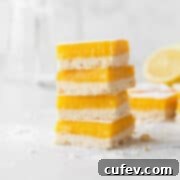
Dairy-Free Lemon Bars
Print
Pin
Rate
Ingredients
Crust
- 1¼ cups all-purpose flour
- ¼ cup granulated sugar
- ¼ teaspoon fine salt
- 10 tablespoons cold vegan butter
Lemon Filling
- 1 cup granulated sugar
- 1 tablespoon cornstarch
- 1½ tablespoons fresh lemon zest
- ⅔ cup fresh lemon juice
- pinch of fine salt
- 3 large eggs
- 3 large egg yolks
- 4 tablespoons vegan butter
- powdered sugar for dusting optional
Instructions
For the Dairy-Free Shortbread Crust
-
Preheat your oven to 350°F (175°C). Line an 8×8-inch square baking pan with parchment paper, ensuring that the paper extends up all four sides of the pan to create convenient handles for lifting.
-
In a medium bowl, combine the all-purpose flour, granulated sugar, and salt. Whisk these dry ingredients together thoroughly. Add the cold, cubed vegan butter and work it into the flour mixture using a fork, a pastry cutter, or your fingertips until it resembles coarse crumbs with some pea-sized pieces of butter. For efficiency, you may also use a food processor for this step.
-
Press the crumbly dough mixture evenly into the bottom of the prepared pan, forming a flat and compact layer. If the dough feels too soft or sticky, place the pan in the freezer for a few minutes to firm it up, making it easier to handle and ensuring a cleaner press.
-
Chill the pan with the pressed dough in the freezer for 5 minutes. Then, bake the crust in the preheated oven for 30 minutes, or until the edges are golden brown. Remove the baked crust from the oven and allow it to cool completely in the pan while you prepare the filling.
For the Dairy-Free Lemon Curd Filling
-
While the crust is cooling, reduce your oven temperature to 325°F (160°C) and allow it to preheat.
-
In a separate bowl, combine the granulated sugar and fresh lemon zest. Use your fingers to vigorously pinch and rub the zest into the sugar; this technique helps to release the potent lemon oils, infusing the sugar with incredible citrus flavor. Transfer this lemon-infused sugar and the cornstarch into a saucepan and whisk until thoroughly combined.
-
Add the fresh lemon juice and a pinch of salt to the saucepan. Heat the mixture over medium heat, whisking occasionally, for 2-3 minutes, or until it begins to thicken slightly and takes on a syrupy consistency. Once thickened, remove the pan from the heat.
-
In a large bowl, whisk the three whole eggs and three egg yolks until smooth and uniformly blended. While whisking constantly and vigorously, slowly drizzle in the hot lemon juice mixture, adding it in very small ¼ cup increments. This gradual addition, known as tempering, prevents the eggs from scrambling.
-
Once all the lemon juice mixture has been fully incorporated into the eggs, pour the entire custard mixture back into the saucepan. Place the saucepan over medium-low heat and continue to cook, whisking constantly to ensure even cooking and prevent sticking.
-
Continue cooking for about 5-7 minutes, or until the mixture reaches 175°F (79°C) on an instant-read thermometer, or is thick enough to generously coat the back of a spoon (it should leave a clear trail when you run your finger across it). Immediately remove the saucepan from the heat.
-
Place a fine-mesh sieve over a clean bowl. Carefully pour the hot lemon curd through the sieve to remove any lemon zest or tiny bits of cooked egg, ensuring an incredibly smooth and silky final texture.
-
While the lemon curd is still warm, add the remaining 4 tablespoons of vegan butter, one tablespoon at a time. Mix well after each addition until the butter is completely melted and incorporated, creating a gorgeously smooth and lustrous lemon curd.
-
Pour the warm lemon curd evenly over the cooled shortbread crust in the prepared pan. Use an offset spatula or the back of a spoon to gently smooth the surface. Bake the lemon bars for 20-25 minutes, or until the mixture appears mostly set but still has a slight, gentle jiggle when you carefully shake the pan.
-
Remove the pan from the oven and let the bars cool completely at room temperature within the pan (this typically takes about 2 hours). After cooling to room temperature, transfer the pan to the refrigerator and chill for at least 1 hour. Once thoroughly chilled, lift the entire slab of bars out of the pan using the parchment paper handles. Place on a cutting board and use a sharp knife to cut them into squares. For the cleanest cuts, wipe the knife blade clean after each slice.
-
For an extra touch of elegance and sweetness, dust the tops of the lemon bars with powdered sugar just before serving. Enjoy your homemade, bright, and buttery dairy-free lemon bars!
Notes
- Storage Directions:
- Refrigeration: Store any leftover dairy-free lemon bars in an airtight container in the refrigerator for up to 3-4 days. It’s normal for the surface to develop some condensation (“sweat”) if covered, but this will not affect their delicious texture or flavor.
- Freezing: These lemon bars freeze beautifully! For best results, wrap individual bars tightly in parchment paper, then place them in a freezer-safe airtight container or a heavy-duty freezer bag. They can be frozen for up to 3 months.
- Defrosting: To thaw, simply let the frozen lemon bars sit at room temperature for 30 minutes to 1 hour, or transfer them to the refrigerator for 2-3 hours before you plan to enjoy them.
- Gluten-Free Adaptation: To make this recipe entirely gluten-free, simply substitute the all-purpose flour with an equal amount (1¼ cups or 185g) of a high-quality 1-to-1 gluten-free baking flour blend. Ensure it’s a blend designed for cup-for-cup replacement in baking. Follow all other recipe directions as listed, and you’ll have perfect dairy-free and gluten-free lemon bars!
